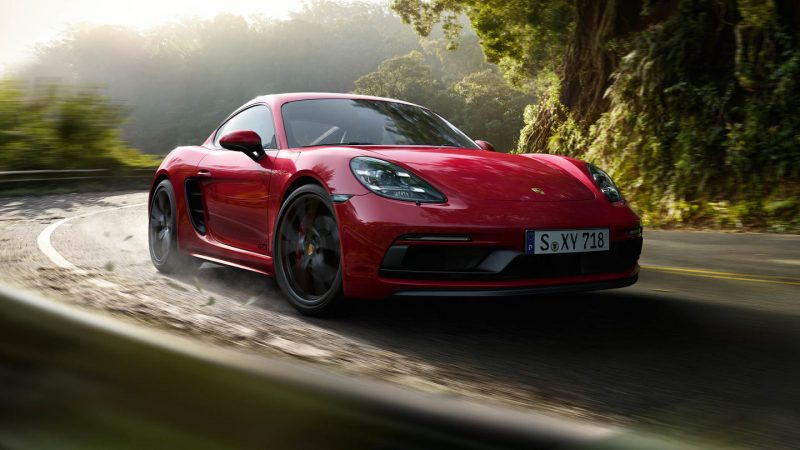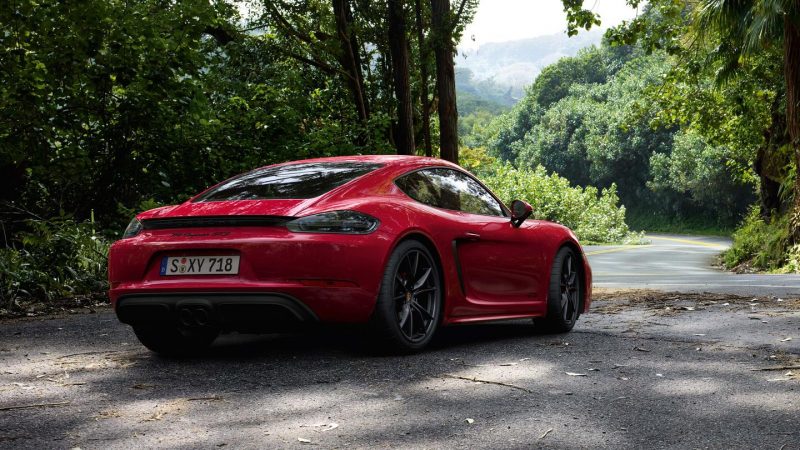Isn’t turbocharging marvelous? As sonorous as the old flat-sixes were, adding power has never been easier in the Boxster and Cayman range. Thanks to a revised intake and flow-optimized turbocharger the GTS makes 15 horsepower more than the S models. This additional power is only part of what sets the GTS apart from the other models in the 718 range. The 718 GTS is currently the top model in the 718 hierarchy thanks to a blend of added power, optimized suspension, and an increased level of configurability over other 718 models as standard.
Chassis and Suspension
All the way back to the 912 and 914, the junior Porsche models have been defined by their balance. The 718 GTS models are no exception. While the 718 S models are very capable, the GTS turns this level of capability up. The standard 20″ Carrera S wheels are finished in black, and measure 8″ wide at the front and 10″ wide at the rear.
The suspension is 10mm lower than the 718 S, and traction and stability control are managed by the PSM system. The 718 GTS also incorporates the Porsche Torque Vectoring (PTV), which gives torque-vectoring capabilities via an electronically controlled differential. For optimal balance, the cars’ Sport Chrono package is tied to the Dynamic Engine Mounts, which improve handling by controlling engine inertia without sacrificing NVH qualities during normal driving.
Engine Improvements
Changes to the 2.5-liter turbocharged flat-four are relatively minor. The intake has been changed to a GTS-specific item, and the turbocharger has been flow-optimized. These changes contribute to a 15 horsepower bump over the 718 Carrera S. Power comes slightly lower in the rev range, with peak power delivered at 6,500 rather than 6,700 RPM. The 0-60 sprint is down to 4.1 seconds with Sport Chrono and PDK.
Sound design was important to the GTS, and Porsche sound engineers created a more aggressive sound profile. In addition to a louder, more racy exhaust note, the GTS also has louder backfires on overrun. As I said before, the cars sound more like Porsches and less like Subarus than previously.
Styling
The GTS’ distinctive look comes from an array of matte black styling features. The 20″ wheels, emblems, exhaust and aero items are all finished in black. The head and taillights also feature blacked-out interior surfaces. The aerodynamic components include a redesigned front fascia with a new chin spoiler and a new rear valence panel.
Aesthetic changes continue inside, and like the 991 GTS, the cabin is trimmed predominantly in Alcantara. The optional Sport Plus seats have Alcantara faces for improved grip between the driver and the seat. The shifter and steering wheel rim are also finished in this low-gloss, high-grip material.
Electronics
The latest generation of the Sport Chrono Package includes a drive-mode selector and integration with the Porsche Track Precision app. The app takes data collected by the acceleromters and telemetry equipment in the car, and displays it on the user’s smartphone. This data can be used to improve on-track performance, and gives the user a baseline to monitor improvements in their driving.
Takeaway
In my eyes, Porsche is knocking it out of the park with the current GTS range. For drivers who want to use their Porsche every day and take it to the track, the GTS range offers a very compelling blend of performance and usability. Unlike the new Carrera T, which I think offers too many compromises for the increased performance, the GTSs seem to be a collection of well optimized all-rounders.
Of course, I’m biased towards GTS models. Just look what I call my 944.
Pricing for US buyers starts at $79,800 for the Cayman GTS and $81,900 for the Boxster GTS.


